This article was co-authored by Claudia Carberry, RD, MS. Claudia Carberry is a Registered Dietitian specializing in kidney transplants and counseling patients for weight loss at the University of Arkansas for Medical Sciences. She is a member of the Arkansas Academy of Nutrition and Dietetics. Claudia received her MS in Nutrition from the University of Tennessee Knoxville in 2010.
There are 10 references cited in this article, which can be found at the bottom of the page.
This article has been viewed 307,781 times.
Nutritious food is no substitute for physical activity, but watching what you eat plays a vital role in developing a strong and healthy body. Combine a balanced diet with careful attention to good nutrition while exercising and you'll ensure that the food you eat is keeping you in great shape.
Steps
Balancing Your Diet
-
1Follow the guidelines of the USDA’s MyPlate. The U.S. government and other public health agencies have developed a variety of food "pyramids" and "plates" over the past several decades. These tools are graphical representations of the various food groups you should eat — and how much of each group you should consume. The quantity of foods you eat from each category in the healthy balance of the plate will vary upon your size, exercise level, and dietary preferences, but a majority of your caloric intake should come from these categories:[1]
- Vegetables and fruits. Aim to fill half your plate with these foods at each meal.
- Healthy proteins, such as fish, poultry, eggs, nuts, beans, seeds, and/or tofu.
- Carbohydrates in the form of whole grains such as oatmeal, whole wheat bread, and brown rice.
- Healthy fats and oils. Healthy choices include unsaturated fats such as olive and vegetable oils, and avocados. Note that fats and oils are calorie-rich, so small quantities add up quickly. Read labels carefully.
- Water, tea, and coffee with little or no added sugar. You should limit your dairy intake to 1 to 2 cups of low-fat milk per day and drink no more than 1 cup of juice per day.
-
2Consume "super foods" that deliver exceptional nutritional benefits. If your aim is fitness as well as general good health, consider eating foods that deliver extra energy, antioxidants, calcium, or heart-healthy fats and proteins.
- Dried fruits, sweet potatoes, and bananas deliver complex carbohydrates that will help you efficiently store and use energy. Each of these foods contains valuable potassium in addition to a host of other nutrients.
- Broccoli and other green vegetables, tomatoes, blueberries, and cocoa all contain antioxidants that remove cell-damaging free radicals from your blood.
- Milk and green vegetables provide calcium to ensure healthy bones. Warm milk consumed near bedtime has the added benefit of boosting the serotonin and melatonin that help you sleep.
- Salmon and nuts deliver healthy fats and proteins. Consider adding Brazil nuts in particular to your diet, as they contain high levels of selenium, a mineral that helps bolster your immune system.[2]
Advertisement -
3Pay attention to portion size. Read food packaging carefully to determine portion size and the number of servings in a given package. Split value packs into portion-sized containers, and consider sharing large restaurant meals.[3] Learn how to identify proper portions using hand-size references; guidelines are readily available online. One serving of carrots, for example, is equivalent to one cup, or approximately the size of an adult fist; a serving of dry cereal is also one cup, or one adult fist, in size.[4]
Consuming Adequate Fiber
-
1Understand the benefits of a diet high in dietary fiber. Foods rich in dietary fiber help you control your hunger and lose weight in a number of ways.
- High fiber foods have a higher "chew factor." Put simply, they take longer to eat, increasing your sense of satisfaction.
- Foods that are high in fiber take longer to exit your digestive tract. This means you feel fuller longer.
- Foods containing soluble fiber such as oatmeal and beans help to stabilize your blood sugar over the course of the day. This means you don't feel as hungry.
- Fiber also helps to lower cholesterol in some individuals and bulk stool for better digestive health.
-
2Choose high fiber foods. Dietary fiber is found in a wide variety of foods, so adding this important element to your diet may be easier than you imagine. Try high-fiber cereals, beans, vegetables, nuts and seeds, and fruits.[5]
-
3Proceed gradually when converting to a high-fiber diet. While your body functions best on a high fiber diet, if you haven't previously been eating much fiber it will need time to adjust. Start by introducing one high fiber element and then continue to improve your diet incrementally. You may replace your low-in-fiber corn flakes with a raisin bran cereal, for example, and then wait a few days before introducing salad with your lunch.
Preparing Fresh Food
-
1Prioritize whole foods. Choosing unprocessed foods allows you to control your diet by eliminating "hidden" ingredients and excess salt.[6] It's possible that weight gain may be coming not from the quantity of food you are eating, but the amount of sugar, salt, and other ingredients that are added to your meal. Whole foods such as vegetables, fruits, whole grains, and fish also tend to reside near the healthy "base" of the food pyramid.
-
2Consider starting a garden. Studies indicate that children who participate in school-based gardening programs are twice as likely to try new foods as those who did not participate in these programs.[7] Nurturing your own vegetables from seeds or seedlings will inspire you toward healthy eating. Growing your own vegetables also saves money, allowing you to keep your body fit without breaking your budget.
-
3Cook from scratch. Much like consuming whole foods, cooking from scratch improves your control over your diet. Not only are you likely to save money by preparing your own meals, but you can eliminate additives, extra sugar and salt, and other processed ingredients.
- Develop your cooking skills gradually. You may become overwhelmed if you try to take on too much, too quickly. Start with easy recipes to increase your confidence. Give yourself permission to learn over time and you'll find cooking is more likely to become an enduring habit.
Eating Properly While Exercising
-
1Prepare for a workout by eating a snack. Eating a snack that consists of a complex carbohydrate and a protein source is a great way to prepare for a workout. For example, you could have a cup of plain Greek yogurt with an apple. Consume your snack 1 to 2 hours before working out.
- Proper hydration before a workout is also important. Plan to drink two to three cups of water, two to three hours before you exercise.
-
2Eat foods that boost your energy and endurance. You may be familiar with various carbohydrate blends of glucose and fructose (sports drinks, gels, etc.) that are commonly used during long workouts. You might, however, want to consider a natural option that combines glucose and fructose with additional vitamins and antioxidants: honey! The darker the honey, the more antioxidants it contains.[8]
- Continue to hydrate during your workout. Drink 3/4 to 1 1/2 cups of water every 15 – 20 minutes, and consider an electrolyte drink if you have been exercising longer than 60 minutes.
-
3Replenish your energy after a long workout. This is your big opportunity to combine a treat with food that will keep your body fit: chocolate milk is an excellent post-workout recovery drink. The carbohydrates it contains will help replenish your energy stores. Try a banana with peanut butter if you aren't fond of milk.
- Drink tart cherry juice after exercise to help ease muscle inflammation. Avoid drinking juice before or during exercise, however, as it can cause stomach cramps.[9]
-
4Consume protein after exercising to help your muscles recover and grow. Good sources of protein include fish, poultry, meat, nuts, beans, seeds, lentils, soy, and milk products. Note that while advertisements for protein supplements often advertise that they provide amino acids the body cannot make, you can obtain the same important nutrients by consuming a variety of protein-rich foods.[10]
-
5Remember that consuming "fitness" foods is no substitute for physical exercise. One prominent study suggests that "fitness branding" encourages consumers to eat more of a given food and exercise less. This can undermine your efforts to keep your body fit. That "fitness" bar has just as many calories as any other food of its size and nutritional content![11]
- Read labels carefully. Energy bars and other "fitness" products often contain significant amounts of added sugar and are usually heavily processed and filled with artificial ingredients. If you do opt to purchase an energy bar, look for bars with about 5 grams (0.2 oz) of protein, some carbohydrates and very little fat.
- Pay attention to the caloric content of your sports drinks and only drink sports drinks if you have been exercising for 60 minutes or longer. If you're exercising to lose weight, opt for water or "light" versions.[12]
References
- ↑ https://www.hsph.harvard.edu/nutritionsource/healthy-eating-plate/
- ↑ http://www.bbcgoodfood.com/howto/guide/our-top-10-fitness-foods
- ↑ http://www.healthyeating.org/Healthy-Eating/Healthy-Living/Weight-Management/Article-Viewer/Article/348/correct-portion-sizes-how-to-keep-portion-distortion-in-check.aspx
- ↑ http://www.healthyeating.org/Portals/0/Documents/Schools/Parent%20Ed/Portion_Sizes_Serving_Chart.pdf
- ↑ http://www.muscleandfitness.com/nutrition/lose-fat/fiber-fixes-fight-hunger-and-promote-health
- ↑ http://www.hsph.harvard.edu/nutritionsource/pyramid-full-story/
- ↑ http://www.livescience.com/27734-school-gardens-broaden-kids-palates.html
- ↑ http://www.eatingwell.com/blogs/health_blog/the_best_fitness_foods_what_to_eat_before_during_and_after_a_workout
- ↑ http://www.eatingwell.com/blogs/health_blog/the_best_fitness_foods_what_to_eat_before_during_and_after_a_workout
About This Article
To keep your body fit with food, monitor your portion size so that the majority of your food is coming from the bottom of the food pyramid. Prioritize fresh foods such as fruits, whole grains, and fish and only eat red meat and white rice in moderation. You can also try adding super foods like broccoli, sweet potatoes and nuts to your diet. Control your hunger and supplement your diet with high-fiber foods like high-fiber cereals or beans. For advice from our dietician reviewer on how to eat properly while exercising, read on!

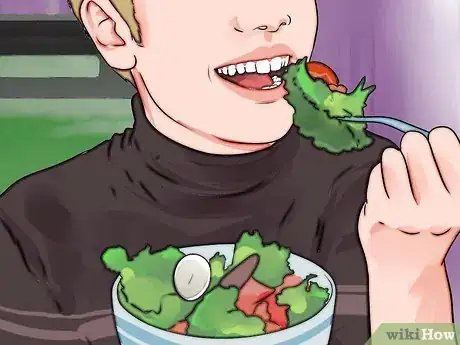


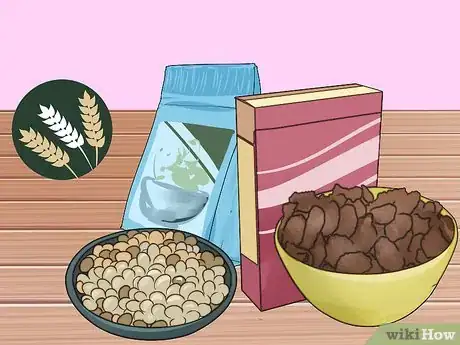
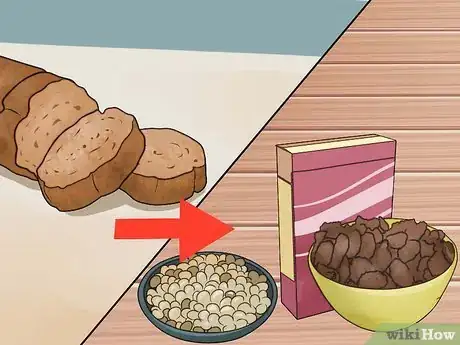
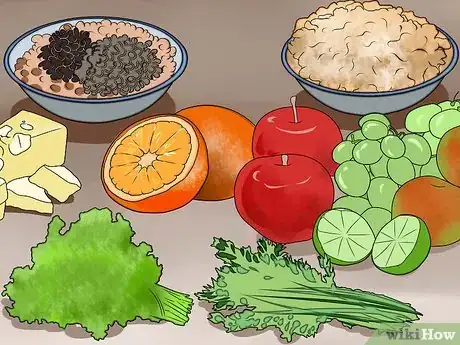
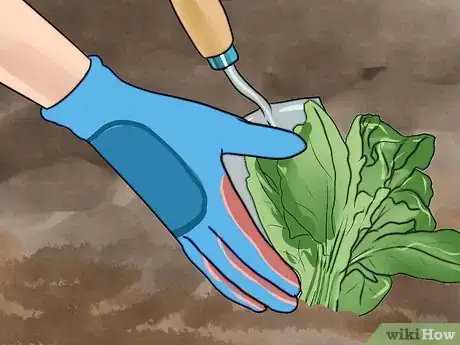
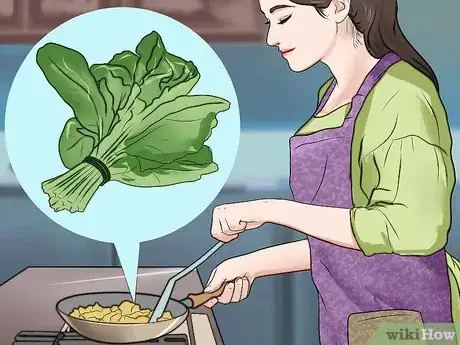
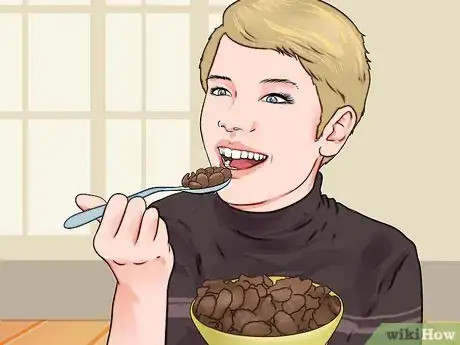

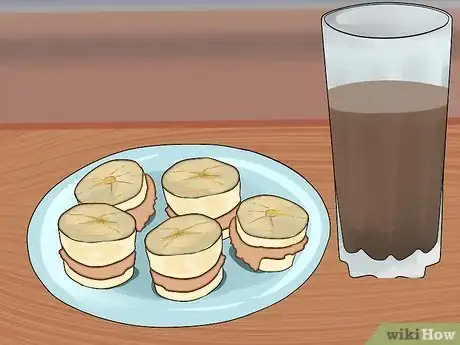
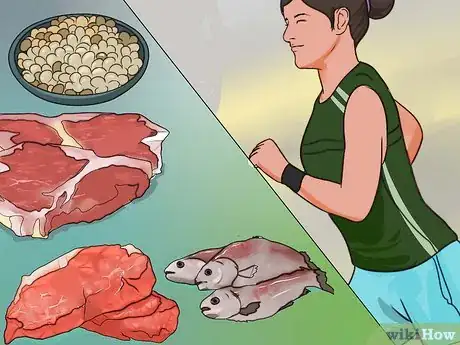
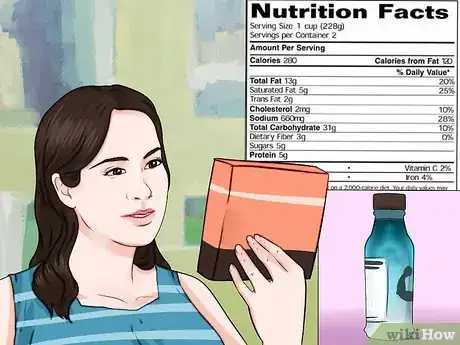





























































Medical Disclaimer
The content of this article is not intended to be a substitute for professional medical advice, examination, diagnosis, or treatment. You should always contact your doctor or other qualified healthcare professional before starting, changing, or stopping any kind of health treatment.
Read More...